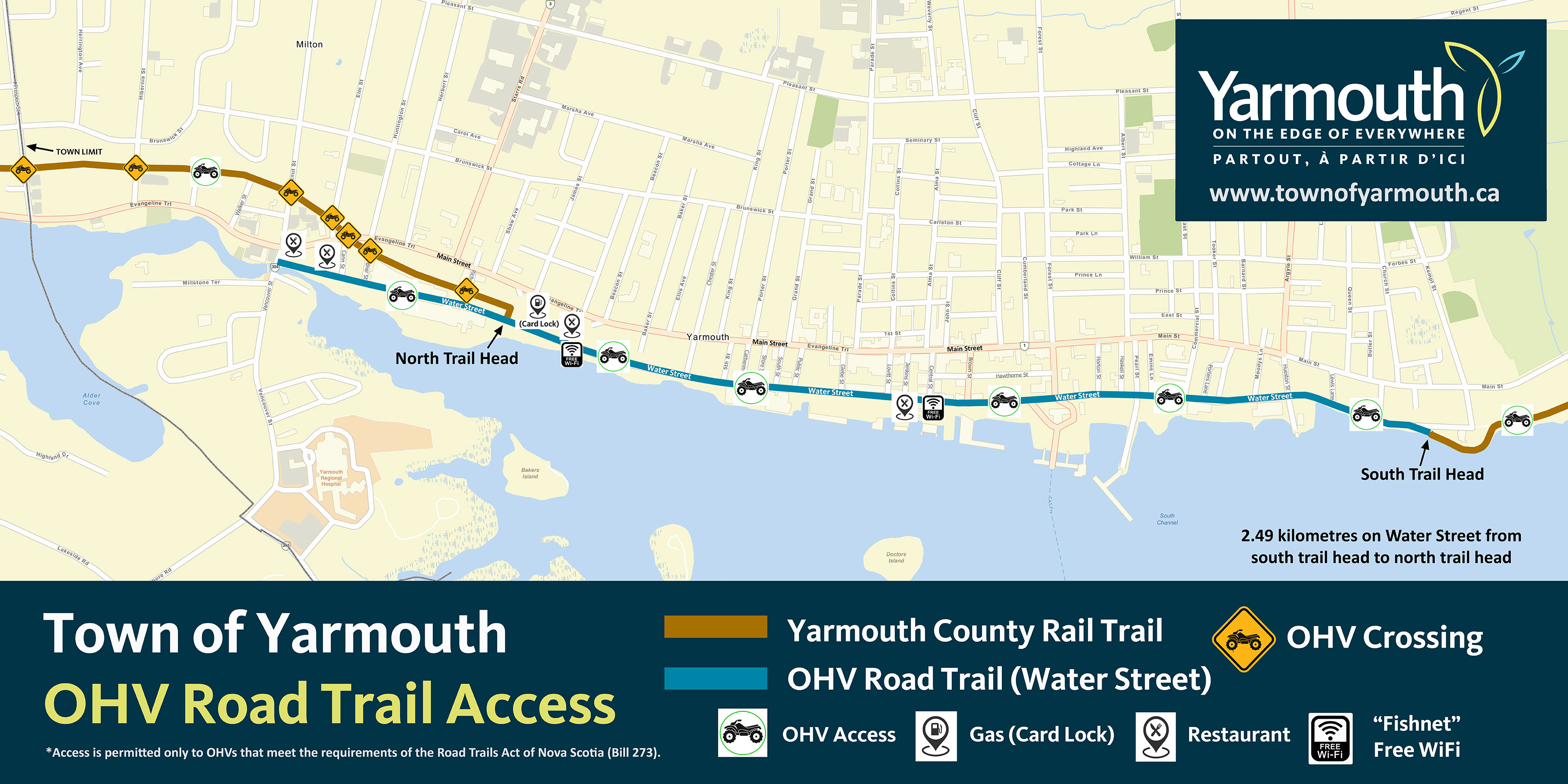For more than a decade, the Town of Yarmouth has actively engaged the province to be part of a pilot program to allow “OHVs” (Off-Highway Vehicles, also commonly called “ATVs”), to access specific streets within town. In the spring of 2023, the province passed Bill 273, the “Road Trails Act” which gives towns like Yarmouth the power to enact their own bylaws allowing OHVs, that meet requirements, to legally access designated streets.
 In response to Bill 273, which became law in September 2023, the Town introduced a bylaw to designate Water Street as open to OHVs that meet the requirements.
In response to Bill 273, which became law in September 2023, the Town introduced a bylaw to designate Water Street as open to OHVs that meet the requirements.
The following is a series of FAQs developed to answer questions about the bylaw, and OHV access to Water Street in Yarmouth.
DEFINITIONS:
OHV designates an “off-highway vehicle”, and also dirtbike, or other Off-Highway Vehicle that meet requirements (also known as “ATVs”)
“Road trail” means the shoulder and travelled portion of a highway designated under this Bylaw.
APPLICABLE LEGISLATIONS:
- BILL NO. 273, Road Trails Act, Province of Nova Scotia
- Motor Vehicle Act
- Off-highway Vehicles Act
- Bylaw (bylaw 80) respecting the Road Trails Act in the Town of Yarmouth
PLEASE NOTE: Driver and passenger assume the risks of using a road trail. The Town of Yarmouth is not liable for injury, damage or death from operating on a road trail.
FREQUENTLY ASKED QUESTIONS
Q: On which streets in Yarmouth are OHVs allowed to travel?
A: At this time, OHVs are only allowed to access Water Street in Yarmouth.
Q: Is Water Street accessible to all OHVs?
A: NOT NECESSARILY. A driver can operate an OHV, dirtbike, or other Off-Highway Vehicle on a Road
Trail if they meet the requirements listed in Bill 273.
Q: What are the key requirements to operate an OHV on Water Street?
A: A rider must have a valid driver’s license (not learners) and third party liability insurance. All riders must also have their OHV legally registered and inspected where applicable. Licence plates must be clearly visible, the same as on motor vehicles. Police can stop any OHV or motor vehicle to check for valid registration, insurance, and driver’s licence.
Q: What are the key safety requirements?
A: Helmets and seatbelts* must be worn (*if OHV was equipped) and OHVs must have a headlight (on), red rear light, and left side mirror.
Q: Which system of signals to indicate turning or stop will be used?
A: Most OHVs are already equipped with brake lights and some brands even have signal lights. If not, riders must use their left hand with the arm to the left to indicate a left turn, the left hand pointing in the air for the right turn and the hand down pointing to the ground to indicate a stop or slowing down.
Q: What if I am in an accident while operating an OHV on Water Street?
A: If in an accident, stop, give information and provide assistance. If there is damage to an unattended vehicle,
make an effort to identify the owner, and otherwise inform police. If a collision/damage occurs involving any OHVs and another OHV, or motor vehicle, it needs to be reported regardless of the amount of damage. Failure to do so, and if the rider(s) drives off, can result in a charge of failing to remain at the scene of an accident. The Registrar will receive and manage reports of accidents damages >$2000 or injury or death of a person.
Q: Are there any restrictions around children as passengers?
A: No children under 9 years old are permitted as passengers while accessing Water Street.
Q: Is there a speed limit set for OHVs using Water Street?
A: Yes, OHVs are not permitted to exceed 25 KPH while using Water Street.
Q: Is there a restriction on the noise made by OHVs?
A: Noise may not exceed Original Manufacturer Specification.
Q: Are there any restrictions on the hours when OHVs can travel on Water Street?
A: No operation 30 minutes after sunset and 30 minutes before sunrise.
Q: Are OHVs permitted to go up any side streets?
A: No. Access is restricted to Water Street at this time.
Q: What amenities are available on Water Street, or nearby?
A: There are restaurants on Water Street, and a fuel provider that offers cardlock service (requires an application with the provider). Riders are encouraged to access the amenities available on Water Street, or park on Water Street and access a variety of nearby businesses, parks, and other attractions in the downtown by foot.
Q: Where can OHV riders park when accessing Water Street?
A: There is designated street parking along much of Water Street that may be used by OHV riders.
Q: Where can I get full details and information about the Provincial Road Trails Act?
A: The full act can be found on the Nova Scotia Legislature website at nslegislature.ca
Q: What else is important to remember when operating an OHV on Water Street?
A: Do not operate an OHV while impaired. Driving while impaired by drugs or alcohol on an OHV carries the exact same penalties as driving a motor vehicle under the influence of drugs or alcohol.
Please ride safely!
Road Trail Map (subject to change). Click the image for a larger version.


